MNG10723 Hospitality: Melbourne Comfort and the 'Home' Concept
VerifiedAdded on 2023/06/04
|12
|2980
|356
Report
AI Summary
This report explores the concept of 'home' in the hospitality industry, particularly how accommodation providers are leveraging it to enhance customer experience. It delves into the tangible and intangible aspects of creating a home-like environment in hotels, covering elements like food, interior design, technology, and service delivery. The report uses Melbourne Comfort, a fictional Australian hotel, as a case study, suggesting specific ways the hotel can implement the 'home' concept to attract and retain customers, including designing rooms with family-friendly layouts, providing essential amenities like Wi-Fi and entertainment systems, and fostering a sense of community through social services and integration with local traditions. The analysis emphasizes the importance of understanding customer culture and preferences to effectively deliver a personalized and comfortable experience that mirrors the feeling of being at home.
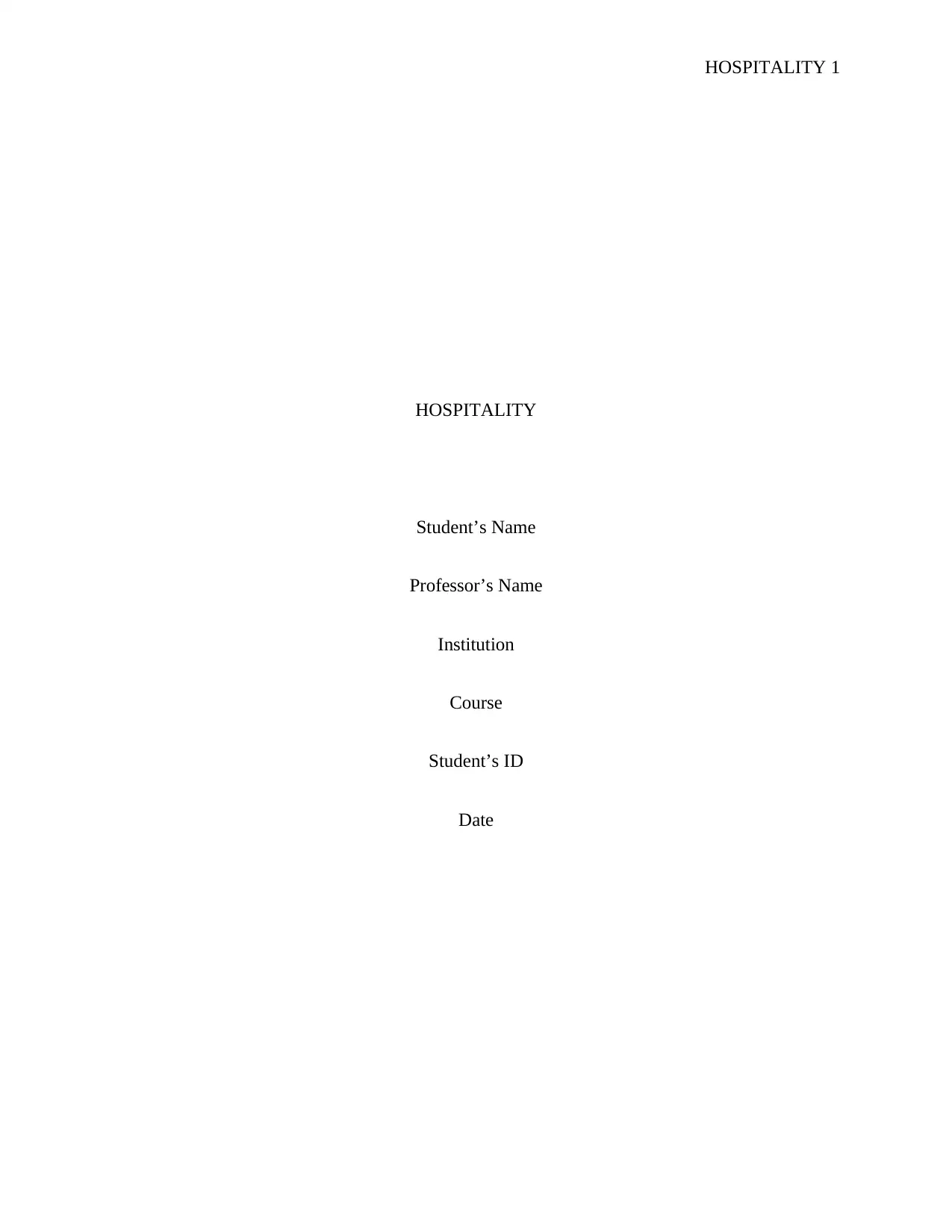
HOSPITALITY 1
HOSPITALITY
Student’s Name
Professor’s Name
Institution
Course
Student’s ID
Date
HOSPITALITY
Student’s Name
Professor’s Name
Institution
Course
Student’s ID
Date
Paraphrase This Document
Need a fresh take? Get an instant paraphrase of this document with our AI Paraphraser
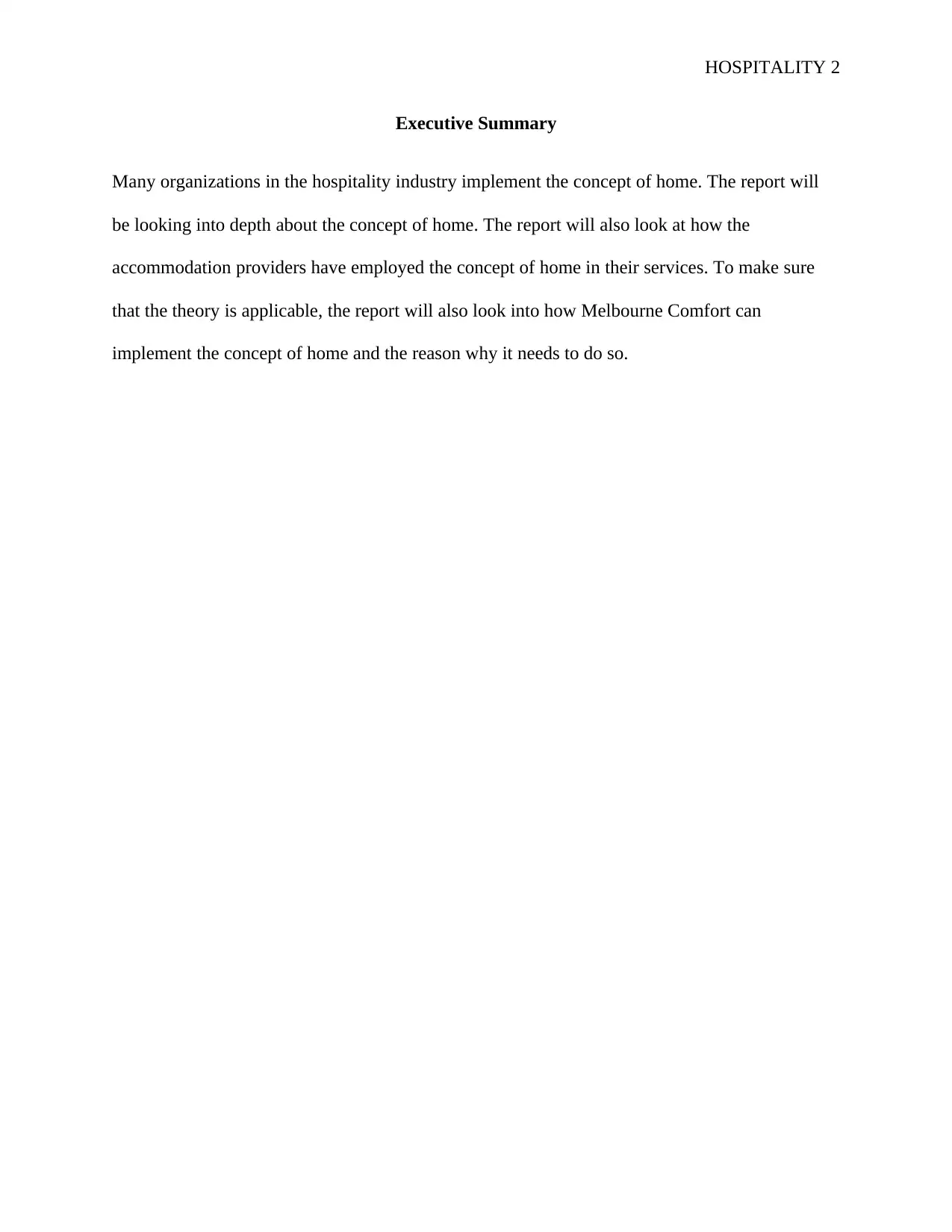
HOSPITALITY 2
Executive Summary
Many organizations in the hospitality industry implement the concept of home. The report will
be looking into depth about the concept of home. The report will also look at how the
accommodation providers have employed the concept of home in their services. To make sure
that the theory is applicable, the report will also look into how Melbourne Comfort can
implement the concept of home and the reason why it needs to do so.
Executive Summary
Many organizations in the hospitality industry implement the concept of home. The report will
be looking into depth about the concept of home. The report will also look at how the
accommodation providers have employed the concept of home in their services. To make sure
that the theory is applicable, the report will also look into how Melbourne Comfort can
implement the concept of home and the reason why it needs to do so.
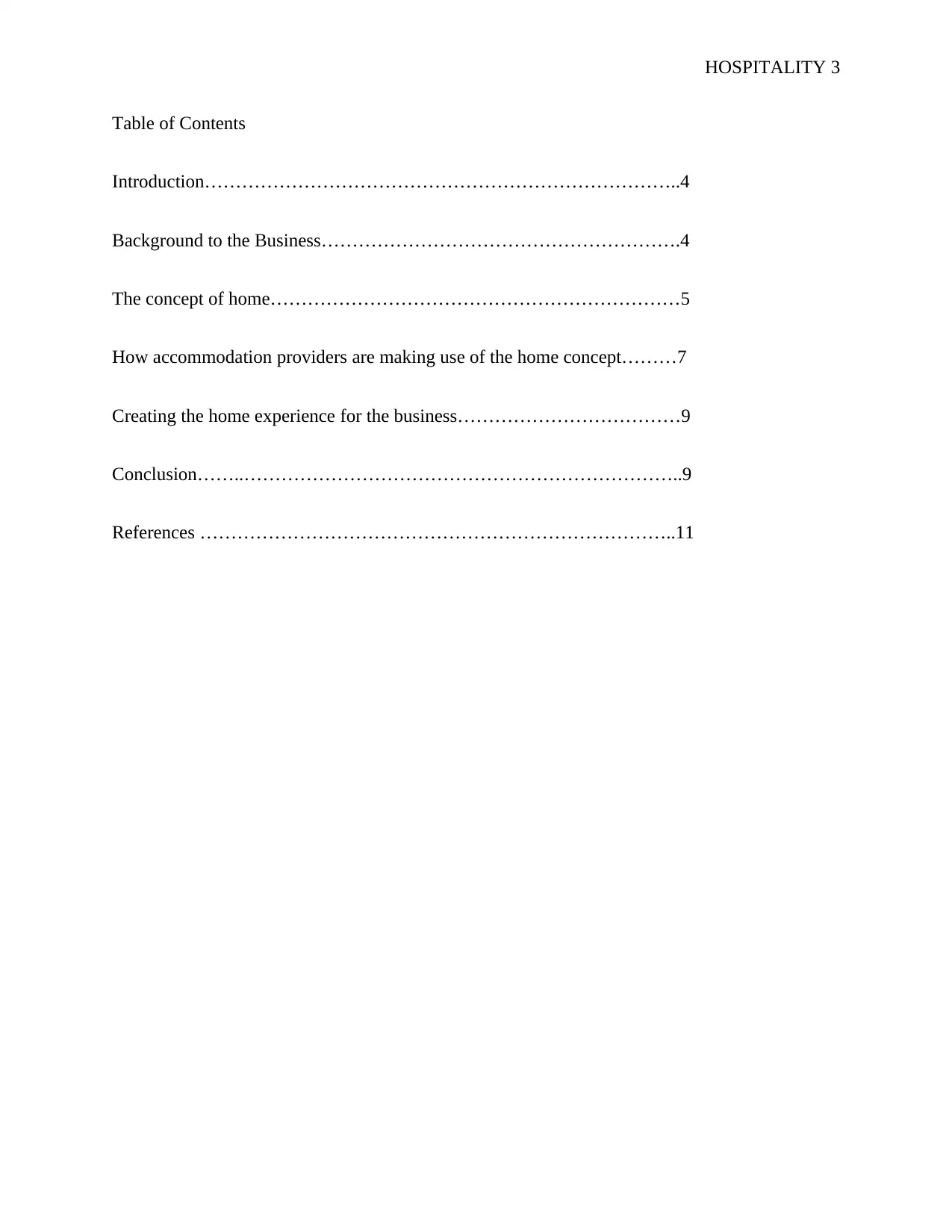
HOSPITALITY 3
Table of Contents
Introduction…………………………………………………………………..4
Background to the Business………………………………………………….4
The concept of home…………………………………………………………5
How accommodation providers are making use of the home concept………7
Creating the home experience for the business………………………………9
Conclusion……..……………………………………………………………..9
References …………………………………………………………………..11
Table of Contents
Introduction…………………………………………………………………..4
Background to the Business………………………………………………….4
The concept of home…………………………………………………………5
How accommodation providers are making use of the home concept………7
Creating the home experience for the business………………………………9
Conclusion……..……………………………………………………………..9
References …………………………………………………………………..11
⊘ This is a preview!⊘
Do you want full access?
Subscribe today to unlock all pages.

Trusted by 1+ million students worldwide
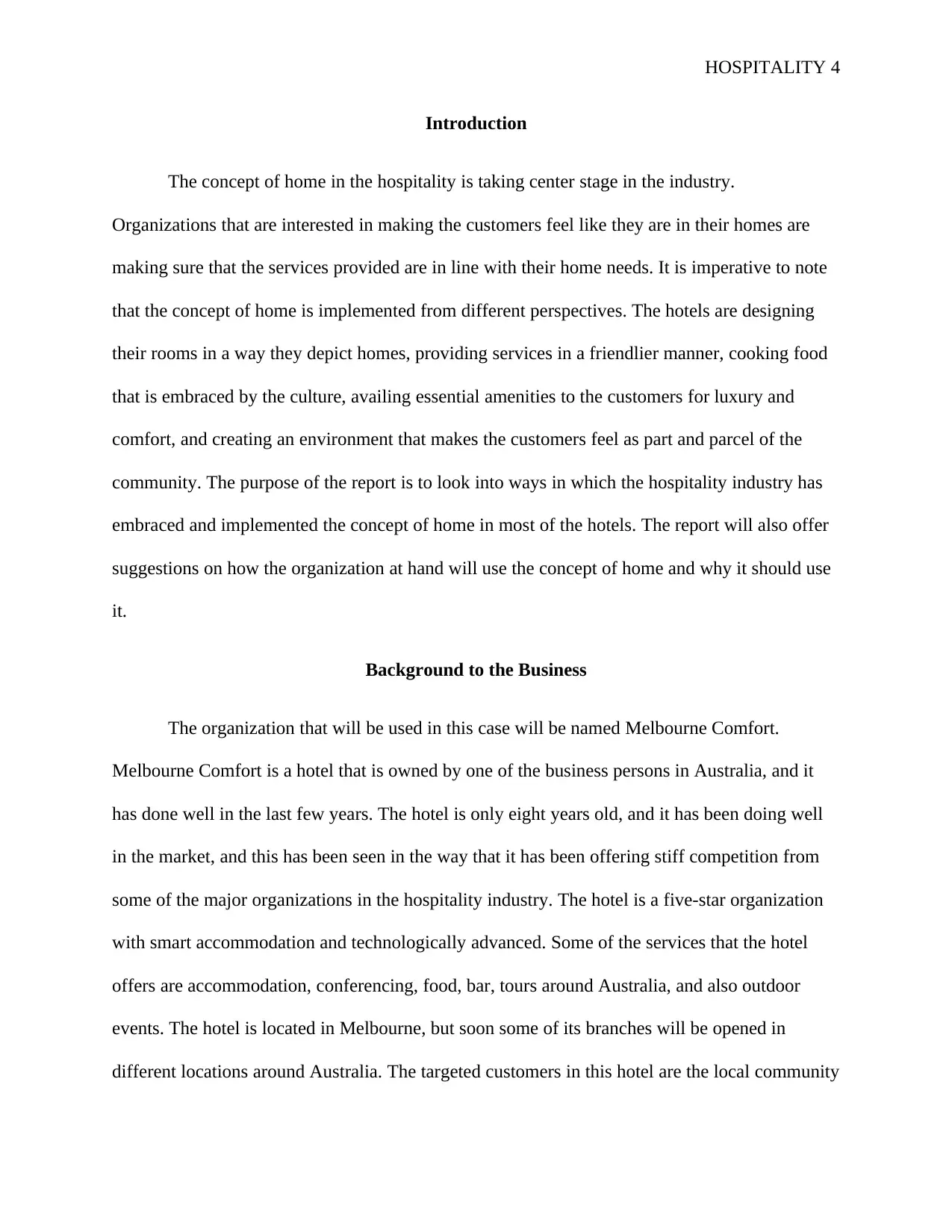
HOSPITALITY 4
Introduction
The concept of home in the hospitality is taking center stage in the industry.
Organizations that are interested in making the customers feel like they are in their homes are
making sure that the services provided are in line with their home needs. It is imperative to note
that the concept of home is implemented from different perspectives. The hotels are designing
their rooms in a way they depict homes, providing services in a friendlier manner, cooking food
that is embraced by the culture, availing essential amenities to the customers for luxury and
comfort, and creating an environment that makes the customers feel as part and parcel of the
community. The purpose of the report is to look into ways in which the hospitality industry has
embraced and implemented the concept of home in most of the hotels. The report will also offer
suggestions on how the organization at hand will use the concept of home and why it should use
it.
Background to the Business
The organization that will be used in this case will be named Melbourne Comfort.
Melbourne Comfort is a hotel that is owned by one of the business persons in Australia, and it
has done well in the last few years. The hotel is only eight years old, and it has been doing well
in the market, and this has been seen in the way that it has been offering stiff competition from
some of the major organizations in the hospitality industry. The hotel is a five-star organization
with smart accommodation and technologically advanced. Some of the services that the hotel
offers are accommodation, conferencing, food, bar, tours around Australia, and also outdoor
events. The hotel is located in Melbourne, but soon some of its branches will be opened in
different locations around Australia. The targeted customers in this hotel are the local community
Introduction
The concept of home in the hospitality is taking center stage in the industry.
Organizations that are interested in making the customers feel like they are in their homes are
making sure that the services provided are in line with their home needs. It is imperative to note
that the concept of home is implemented from different perspectives. The hotels are designing
their rooms in a way they depict homes, providing services in a friendlier manner, cooking food
that is embraced by the culture, availing essential amenities to the customers for luxury and
comfort, and creating an environment that makes the customers feel as part and parcel of the
community. The purpose of the report is to look into ways in which the hospitality industry has
embraced and implemented the concept of home in most of the hotels. The report will also offer
suggestions on how the organization at hand will use the concept of home and why it should use
it.
Background to the Business
The organization that will be used in this case will be named Melbourne Comfort.
Melbourne Comfort is a hotel that is owned by one of the business persons in Australia, and it
has done well in the last few years. The hotel is only eight years old, and it has been doing well
in the market, and this has been seen in the way that it has been offering stiff competition from
some of the major organizations in the hospitality industry. The hotel is a five-star organization
with smart accommodation and technologically advanced. Some of the services that the hotel
offers are accommodation, conferencing, food, bar, tours around Australia, and also outdoor
events. The hotel is located in Melbourne, but soon some of its branches will be opened in
different locations around Australia. The targeted customers in this hotel are the local community
Paraphrase This Document
Need a fresh take? Get an instant paraphrase of this document with our AI Paraphraser
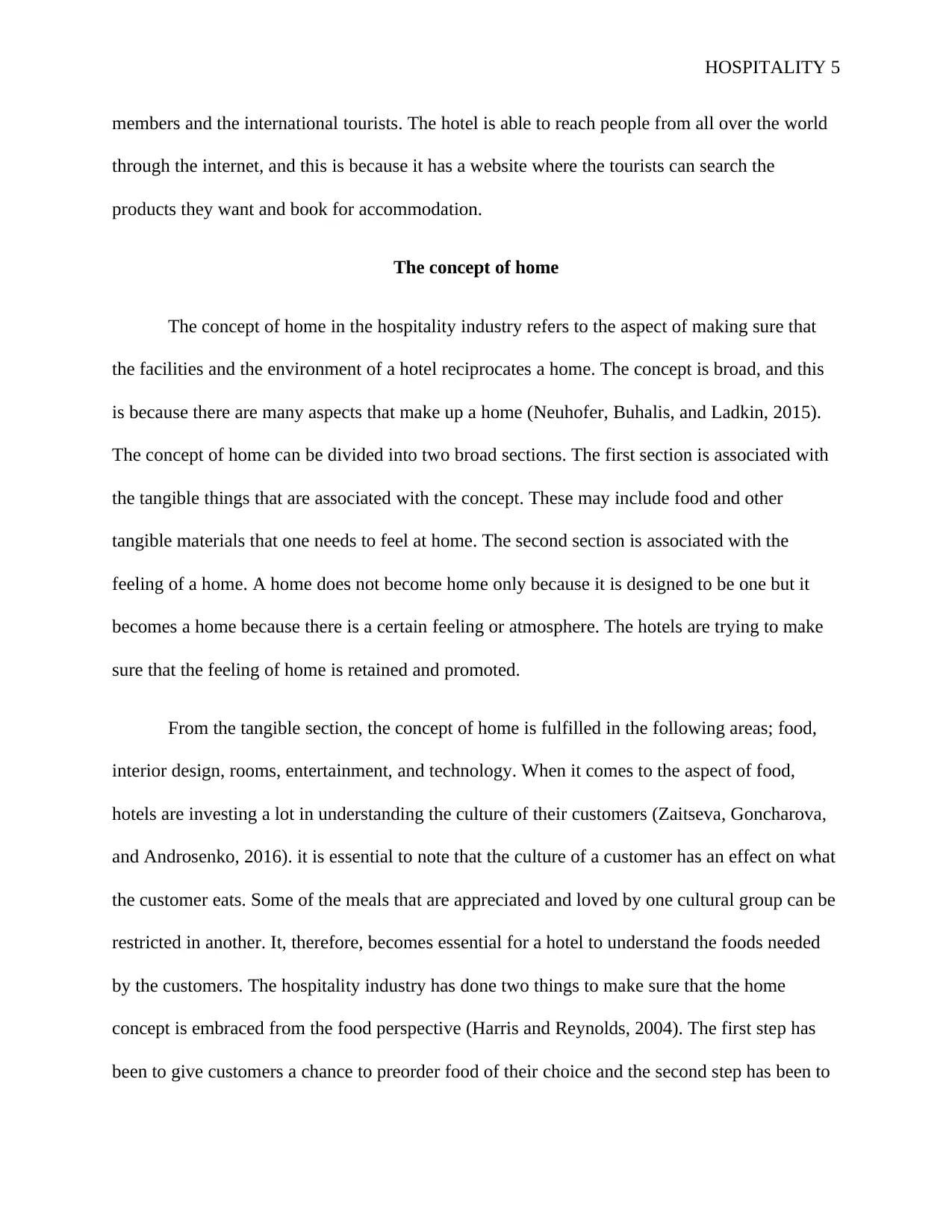
HOSPITALITY 5
members and the international tourists. The hotel is able to reach people from all over the world
through the internet, and this is because it has a website where the tourists can search the
products they want and book for accommodation.
The concept of home
The concept of home in the hospitality industry refers to the aspect of making sure that
the facilities and the environment of a hotel reciprocates a home. The concept is broad, and this
is because there are many aspects that make up a home (Neuhofer, Buhalis, and Ladkin, 2015).
The concept of home can be divided into two broad sections. The first section is associated with
the tangible things that are associated with the concept. These may include food and other
tangible materials that one needs to feel at home. The second section is associated with the
feeling of a home. A home does not become home only because it is designed to be one but it
becomes a home because there is a certain feeling or atmosphere. The hotels are trying to make
sure that the feeling of home is retained and promoted.
From the tangible section, the concept of home is fulfilled in the following areas; food,
interior design, rooms, entertainment, and technology. When it comes to the aspect of food,
hotels are investing a lot in understanding the culture of their customers (Zaitseva, Goncharova,
and Androsenko, 2016). it is essential to note that the culture of a customer has an effect on what
the customer eats. Some of the meals that are appreciated and loved by one cultural group can be
restricted in another. It, therefore, becomes essential for a hotel to understand the foods needed
by the customers. The hospitality industry has done two things to make sure that the home
concept is embraced from the food perspective (Harris and Reynolds, 2004). The first step has
been to give customers a chance to preorder food of their choice and the second step has been to
members and the international tourists. The hotel is able to reach people from all over the world
through the internet, and this is because it has a website where the tourists can search the
products they want and book for accommodation.
The concept of home
The concept of home in the hospitality industry refers to the aspect of making sure that
the facilities and the environment of a hotel reciprocates a home. The concept is broad, and this
is because there are many aspects that make up a home (Neuhofer, Buhalis, and Ladkin, 2015).
The concept of home can be divided into two broad sections. The first section is associated with
the tangible things that are associated with the concept. These may include food and other
tangible materials that one needs to feel at home. The second section is associated with the
feeling of a home. A home does not become home only because it is designed to be one but it
becomes a home because there is a certain feeling or atmosphere. The hotels are trying to make
sure that the feeling of home is retained and promoted.
From the tangible section, the concept of home is fulfilled in the following areas; food,
interior design, rooms, entertainment, and technology. When it comes to the aspect of food,
hotels are investing a lot in understanding the culture of their customers (Zaitseva, Goncharova,
and Androsenko, 2016). it is essential to note that the culture of a customer has an effect on what
the customer eats. Some of the meals that are appreciated and loved by one cultural group can be
restricted in another. It, therefore, becomes essential for a hotel to understand the foods needed
by the customers. The hospitality industry has done two things to make sure that the home
concept is embraced from the food perspective (Harris and Reynolds, 2004). The first step has
been to give customers a chance to preorder food of their choice and the second step has been to
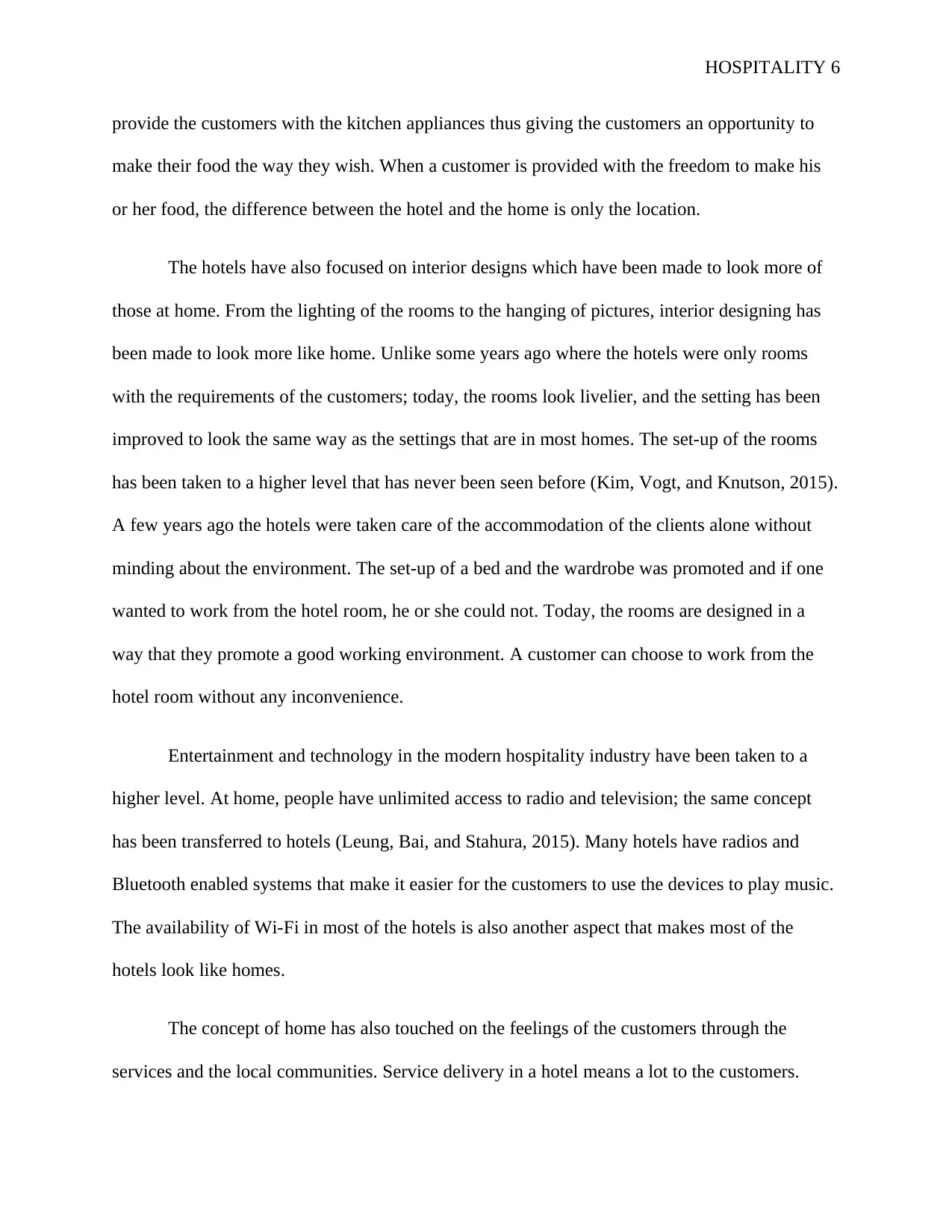
HOSPITALITY 6
provide the customers with the kitchen appliances thus giving the customers an opportunity to
make their food the way they wish. When a customer is provided with the freedom to make his
or her food, the difference between the hotel and the home is only the location.
The hotels have also focused on interior designs which have been made to look more of
those at home. From the lighting of the rooms to the hanging of pictures, interior designing has
been made to look more like home. Unlike some years ago where the hotels were only rooms
with the requirements of the customers; today, the rooms look livelier, and the setting has been
improved to look the same way as the settings that are in most homes. The set-up of the rooms
has been taken to a higher level that has never been seen before (Kim, Vogt, and Knutson, 2015).
A few years ago the hotels were taken care of the accommodation of the clients alone without
minding about the environment. The set-up of a bed and the wardrobe was promoted and if one
wanted to work from the hotel room, he or she could not. Today, the rooms are designed in a
way that they promote a good working environment. A customer can choose to work from the
hotel room without any inconvenience.
Entertainment and technology in the modern hospitality industry have been taken to a
higher level. At home, people have unlimited access to radio and television; the same concept
has been transferred to hotels (Leung, Bai, and Stahura, 2015). Many hotels have radios and
Bluetooth enabled systems that make it easier for the customers to use the devices to play music.
The availability of Wi-Fi in most of the hotels is also another aspect that makes most of the
hotels look like homes.
The concept of home has also touched on the feelings of the customers through the
services and the local communities. Service delivery in a hotel means a lot to the customers.
provide the customers with the kitchen appliances thus giving the customers an opportunity to
make their food the way they wish. When a customer is provided with the freedom to make his
or her food, the difference between the hotel and the home is only the location.
The hotels have also focused on interior designs which have been made to look more of
those at home. From the lighting of the rooms to the hanging of pictures, interior designing has
been made to look more like home. Unlike some years ago where the hotels were only rooms
with the requirements of the customers; today, the rooms look livelier, and the setting has been
improved to look the same way as the settings that are in most homes. The set-up of the rooms
has been taken to a higher level that has never been seen before (Kim, Vogt, and Knutson, 2015).
A few years ago the hotels were taken care of the accommodation of the clients alone without
minding about the environment. The set-up of a bed and the wardrobe was promoted and if one
wanted to work from the hotel room, he or she could not. Today, the rooms are designed in a
way that they promote a good working environment. A customer can choose to work from the
hotel room without any inconvenience.
Entertainment and technology in the modern hospitality industry have been taken to a
higher level. At home, people have unlimited access to radio and television; the same concept
has been transferred to hotels (Leung, Bai, and Stahura, 2015). Many hotels have radios and
Bluetooth enabled systems that make it easier for the customers to use the devices to play music.
The availability of Wi-Fi in most of the hotels is also another aspect that makes most of the
hotels look like homes.
The concept of home has also touched on the feelings of the customers through the
services and the local communities. Service delivery in a hotel means a lot to the customers.
⊘ This is a preview!⊘
Do you want full access?
Subscribe today to unlock all pages.

Trusted by 1+ million students worldwide
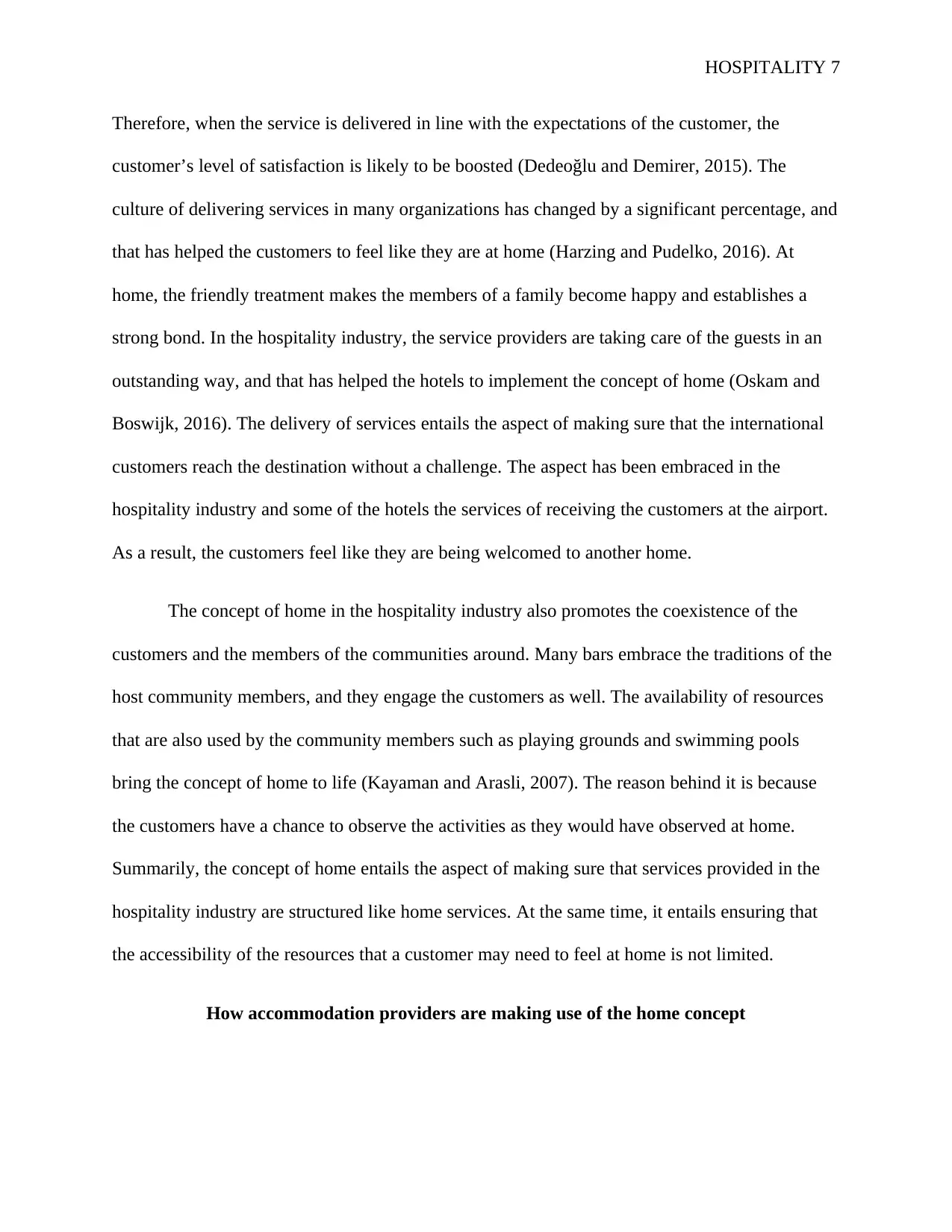
HOSPITALITY 7
Therefore, when the service is delivered in line with the expectations of the customer, the
customer’s level of satisfaction is likely to be boosted (Dedeoğlu and Demirer, 2015). The
culture of delivering services in many organizations has changed by a significant percentage, and
that has helped the customers to feel like they are at home (Harzing and Pudelko, 2016). At
home, the friendly treatment makes the members of a family become happy and establishes a
strong bond. In the hospitality industry, the service providers are taking care of the guests in an
outstanding way, and that has helped the hotels to implement the concept of home (Oskam and
Boswijk, 2016). The delivery of services entails the aspect of making sure that the international
customers reach the destination without a challenge. The aspect has been embraced in the
hospitality industry and some of the hotels the services of receiving the customers at the airport.
As a result, the customers feel like they are being welcomed to another home.
The concept of home in the hospitality industry also promotes the coexistence of the
customers and the members of the communities around. Many bars embrace the traditions of the
host community members, and they engage the customers as well. The availability of resources
that are also used by the community members such as playing grounds and swimming pools
bring the concept of home to life (Kayaman and Arasli, 2007). The reason behind it is because
the customers have a chance to observe the activities as they would have observed at home.
Summarily, the concept of home entails the aspect of making sure that services provided in the
hospitality industry are structured like home services. At the same time, it entails ensuring that
the accessibility of the resources that a customer may need to feel at home is not limited.
How accommodation providers are making use of the home concept
Therefore, when the service is delivered in line with the expectations of the customer, the
customer’s level of satisfaction is likely to be boosted (Dedeoğlu and Demirer, 2015). The
culture of delivering services in many organizations has changed by a significant percentage, and
that has helped the customers to feel like they are at home (Harzing and Pudelko, 2016). At
home, the friendly treatment makes the members of a family become happy and establishes a
strong bond. In the hospitality industry, the service providers are taking care of the guests in an
outstanding way, and that has helped the hotels to implement the concept of home (Oskam and
Boswijk, 2016). The delivery of services entails the aspect of making sure that the international
customers reach the destination without a challenge. The aspect has been embraced in the
hospitality industry and some of the hotels the services of receiving the customers at the airport.
As a result, the customers feel like they are being welcomed to another home.
The concept of home in the hospitality industry also promotes the coexistence of the
customers and the members of the communities around. Many bars embrace the traditions of the
host community members, and they engage the customers as well. The availability of resources
that are also used by the community members such as playing grounds and swimming pools
bring the concept of home to life (Kayaman and Arasli, 2007). The reason behind it is because
the customers have a chance to observe the activities as they would have observed at home.
Summarily, the concept of home entails the aspect of making sure that services provided in the
hospitality industry are structured like home services. At the same time, it entails ensuring that
the accessibility of the resources that a customer may need to feel at home is not limited.
How accommodation providers are making use of the home concept
Paraphrase This Document
Need a fresh take? Get an instant paraphrase of this document with our AI Paraphraser
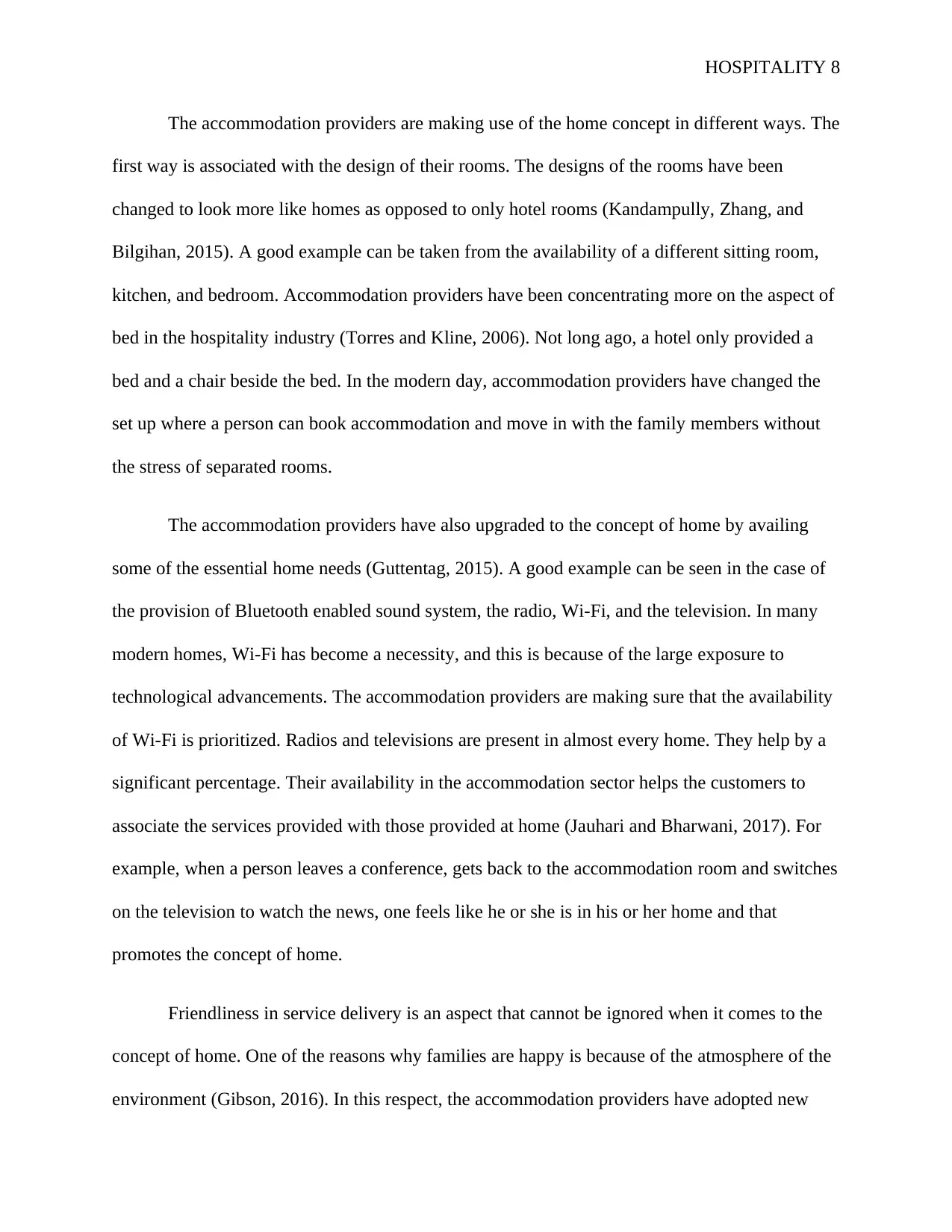
HOSPITALITY 8
The accommodation providers are making use of the home concept in different ways. The
first way is associated with the design of their rooms. The designs of the rooms have been
changed to look more like homes as opposed to only hotel rooms (Kandampully, Zhang, and
Bilgihan, 2015). A good example can be taken from the availability of a different sitting room,
kitchen, and bedroom. Accommodation providers have been concentrating more on the aspect of
bed in the hospitality industry (Torres and Kline, 2006). Not long ago, a hotel only provided a
bed and a chair beside the bed. In the modern day, accommodation providers have changed the
set up where a person can book accommodation and move in with the family members without
the stress of separated rooms.
The accommodation providers have also upgraded to the concept of home by availing
some of the essential home needs (Guttentag, 2015). A good example can be seen in the case of
the provision of Bluetooth enabled sound system, the radio, Wi-Fi, and the television. In many
modern homes, Wi-Fi has become a necessity, and this is because of the large exposure to
technological advancements. The accommodation providers are making sure that the availability
of Wi-Fi is prioritized. Radios and televisions are present in almost every home. They help by a
significant percentage. Their availability in the accommodation sector helps the customers to
associate the services provided with those provided at home (Jauhari and Bharwani, 2017). For
example, when a person leaves a conference, gets back to the accommodation room and switches
on the television to watch the news, one feels like he or she is in his or her home and that
promotes the concept of home.
Friendliness in service delivery is an aspect that cannot be ignored when it comes to the
concept of home. One of the reasons why families are happy is because of the atmosphere of the
environment (Gibson, 2016). In this respect, the accommodation providers have adopted new
The accommodation providers are making use of the home concept in different ways. The
first way is associated with the design of their rooms. The designs of the rooms have been
changed to look more like homes as opposed to only hotel rooms (Kandampully, Zhang, and
Bilgihan, 2015). A good example can be taken from the availability of a different sitting room,
kitchen, and bedroom. Accommodation providers have been concentrating more on the aspect of
bed in the hospitality industry (Torres and Kline, 2006). Not long ago, a hotel only provided a
bed and a chair beside the bed. In the modern day, accommodation providers have changed the
set up where a person can book accommodation and move in with the family members without
the stress of separated rooms.
The accommodation providers have also upgraded to the concept of home by availing
some of the essential home needs (Guttentag, 2015). A good example can be seen in the case of
the provision of Bluetooth enabled sound system, the radio, Wi-Fi, and the television. In many
modern homes, Wi-Fi has become a necessity, and this is because of the large exposure to
technological advancements. The accommodation providers are making sure that the availability
of Wi-Fi is prioritized. Radios and televisions are present in almost every home. They help by a
significant percentage. Their availability in the accommodation sector helps the customers to
associate the services provided with those provided at home (Jauhari and Bharwani, 2017). For
example, when a person leaves a conference, gets back to the accommodation room and switches
on the television to watch the news, one feels like he or she is in his or her home and that
promotes the concept of home.
Friendliness in service delivery is an aspect that cannot be ignored when it comes to the
concept of home. One of the reasons why families are happy is because of the atmosphere of the
environment (Gibson, 2016). In this respect, the accommodation providers have adopted new
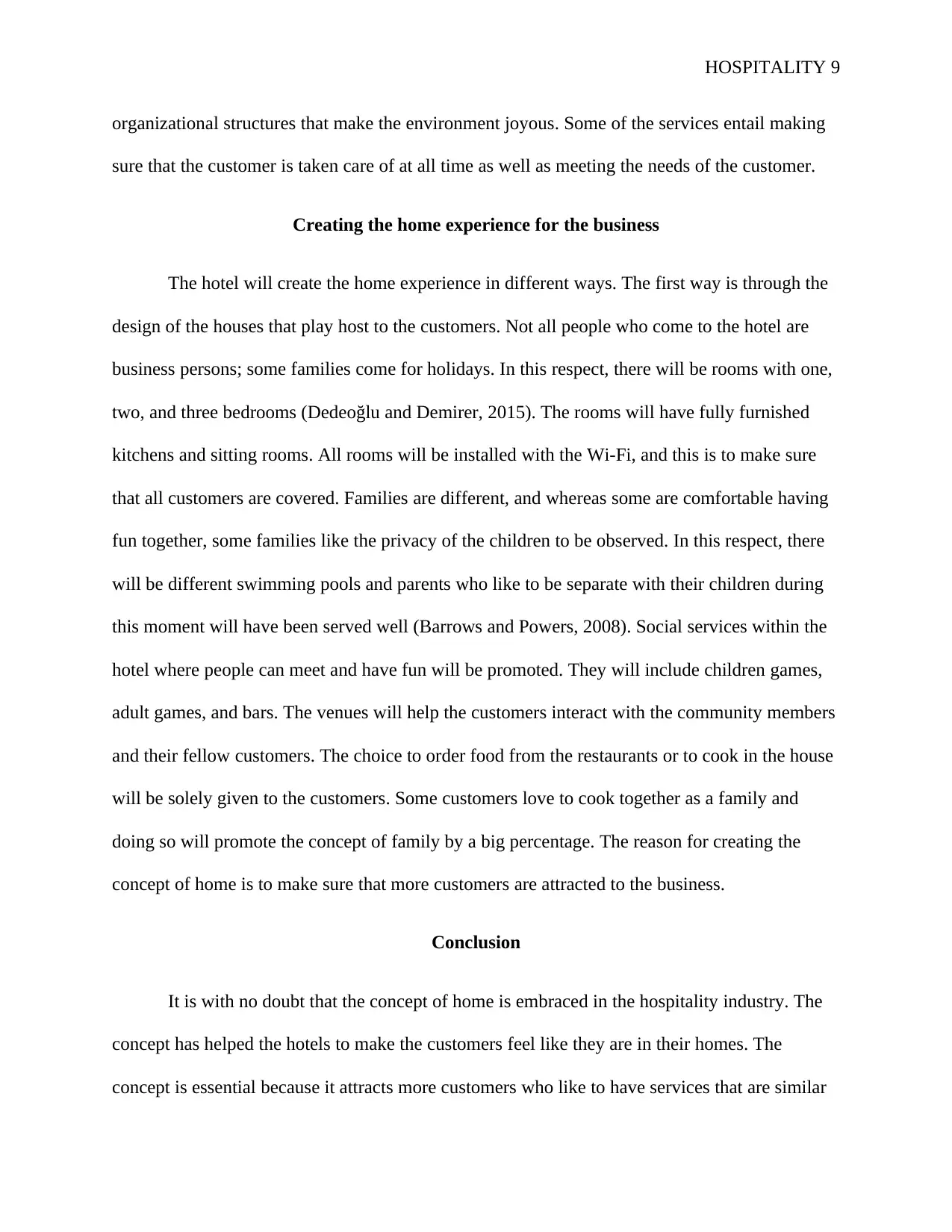
HOSPITALITY 9
organizational structures that make the environment joyous. Some of the services entail making
sure that the customer is taken care of at all time as well as meeting the needs of the customer.
Creating the home experience for the business
The hotel will create the home experience in different ways. The first way is through the
design of the houses that play host to the customers. Not all people who come to the hotel are
business persons; some families come for holidays. In this respect, there will be rooms with one,
two, and three bedrooms (Dedeoğlu and Demirer, 2015). The rooms will have fully furnished
kitchens and sitting rooms. All rooms will be installed with the Wi-Fi, and this is to make sure
that all customers are covered. Families are different, and whereas some are comfortable having
fun together, some families like the privacy of the children to be observed. In this respect, there
will be different swimming pools and parents who like to be separate with their children during
this moment will have been served well (Barrows and Powers, 2008). Social services within the
hotel where people can meet and have fun will be promoted. They will include children games,
adult games, and bars. The venues will help the customers interact with the community members
and their fellow customers. The choice to order food from the restaurants or to cook in the house
will be solely given to the customers. Some customers love to cook together as a family and
doing so will promote the concept of family by a big percentage. The reason for creating the
concept of home is to make sure that more customers are attracted to the business.
Conclusion
It is with no doubt that the concept of home is embraced in the hospitality industry. The
concept has helped the hotels to make the customers feel like they are in their homes. The
concept is essential because it attracts more customers who like to have services that are similar
organizational structures that make the environment joyous. Some of the services entail making
sure that the customer is taken care of at all time as well as meeting the needs of the customer.
Creating the home experience for the business
The hotel will create the home experience in different ways. The first way is through the
design of the houses that play host to the customers. Not all people who come to the hotel are
business persons; some families come for holidays. In this respect, there will be rooms with one,
two, and three bedrooms (Dedeoğlu and Demirer, 2015). The rooms will have fully furnished
kitchens and sitting rooms. All rooms will be installed with the Wi-Fi, and this is to make sure
that all customers are covered. Families are different, and whereas some are comfortable having
fun together, some families like the privacy of the children to be observed. In this respect, there
will be different swimming pools and parents who like to be separate with their children during
this moment will have been served well (Barrows and Powers, 2008). Social services within the
hotel where people can meet and have fun will be promoted. They will include children games,
adult games, and bars. The venues will help the customers interact with the community members
and their fellow customers. The choice to order food from the restaurants or to cook in the house
will be solely given to the customers. Some customers love to cook together as a family and
doing so will promote the concept of family by a big percentage. The reason for creating the
concept of home is to make sure that more customers are attracted to the business.
Conclusion
It is with no doubt that the concept of home is embraced in the hospitality industry. The
concept has helped the hotels to make the customers feel like they are in their homes. The
concept is essential because it attracts more customers who like to have services that are similar
⊘ This is a preview!⊘
Do you want full access?
Subscribe today to unlock all pages.

Trusted by 1+ million students worldwide

HOSPITALITY 10
to those they receive at home. Organizations that have adopted the concept of home are
advantaged over their counterparts in the business.
to those they receive at home. Organizations that have adopted the concept of home are
advantaged over their counterparts in the business.
Paraphrase This Document
Need a fresh take? Get an instant paraphrase of this document with our AI Paraphraser
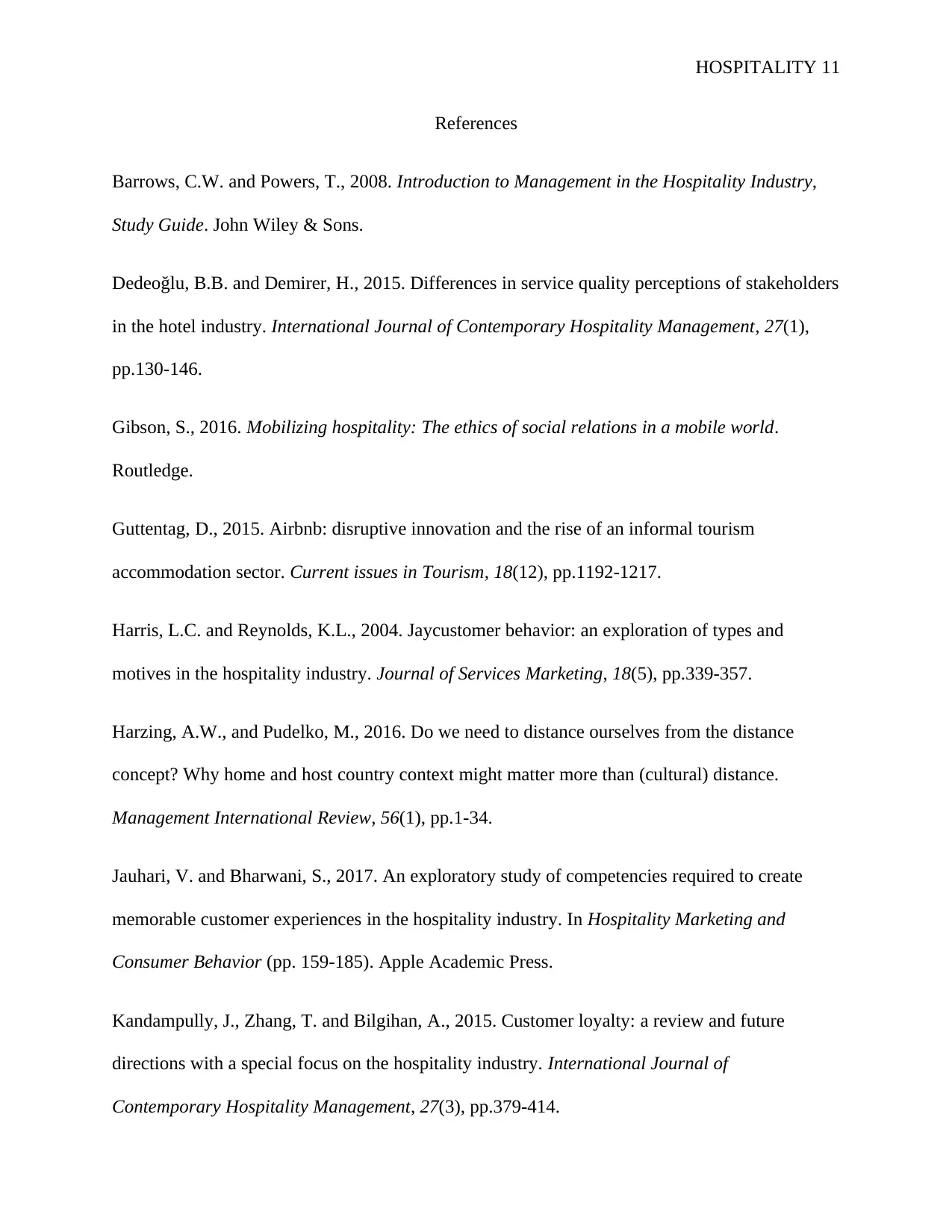
HOSPITALITY 11
References
Barrows, C.W. and Powers, T., 2008. Introduction to Management in the Hospitality Industry,
Study Guide. John Wiley & Sons.
Dedeoğlu, B.B. and Demirer, H., 2015. Differences in service quality perceptions of stakeholders
in the hotel industry. International Journal of Contemporary Hospitality Management, 27(1),
pp.130-146.
Gibson, S., 2016. Mobilizing hospitality: The ethics of social relations in a mobile world.
Routledge.
Guttentag, D., 2015. Airbnb: disruptive innovation and the rise of an informal tourism
accommodation sector. Current issues in Tourism, 18(12), pp.1192-1217.
Harris, L.C. and Reynolds, K.L., 2004. Jaycustomer behavior: an exploration of types and
motives in the hospitality industry. Journal of Services Marketing, 18(5), pp.339-357.
Harzing, A.W., and Pudelko, M., 2016. Do we need to distance ourselves from the distance
concept? Why home and host country context might matter more than (cultural) distance.
Management International Review, 56(1), pp.1-34.
Jauhari, V. and Bharwani, S., 2017. An exploratory study of competencies required to create
memorable customer experiences in the hospitality industry. In Hospitality Marketing and
Consumer Behavior (pp. 159-185). Apple Academic Press.
Kandampully, J., Zhang, T. and Bilgihan, A., 2015. Customer loyalty: a review and future
directions with a special focus on the hospitality industry. International Journal of
Contemporary Hospitality Management, 27(3), pp.379-414.
References
Barrows, C.W. and Powers, T., 2008. Introduction to Management in the Hospitality Industry,
Study Guide. John Wiley & Sons.
Dedeoğlu, B.B. and Demirer, H., 2015. Differences in service quality perceptions of stakeholders
in the hotel industry. International Journal of Contemporary Hospitality Management, 27(1),
pp.130-146.
Gibson, S., 2016. Mobilizing hospitality: The ethics of social relations in a mobile world.
Routledge.
Guttentag, D., 2015. Airbnb: disruptive innovation and the rise of an informal tourism
accommodation sector. Current issues in Tourism, 18(12), pp.1192-1217.
Harris, L.C. and Reynolds, K.L., 2004. Jaycustomer behavior: an exploration of types and
motives in the hospitality industry. Journal of Services Marketing, 18(5), pp.339-357.
Harzing, A.W., and Pudelko, M., 2016. Do we need to distance ourselves from the distance
concept? Why home and host country context might matter more than (cultural) distance.
Management International Review, 56(1), pp.1-34.
Jauhari, V. and Bharwani, S., 2017. An exploratory study of competencies required to create
memorable customer experiences in the hospitality industry. In Hospitality Marketing and
Consumer Behavior (pp. 159-185). Apple Academic Press.
Kandampully, J., Zhang, T. and Bilgihan, A., 2015. Customer loyalty: a review and future
directions with a special focus on the hospitality industry. International Journal of
Contemporary Hospitality Management, 27(3), pp.379-414.
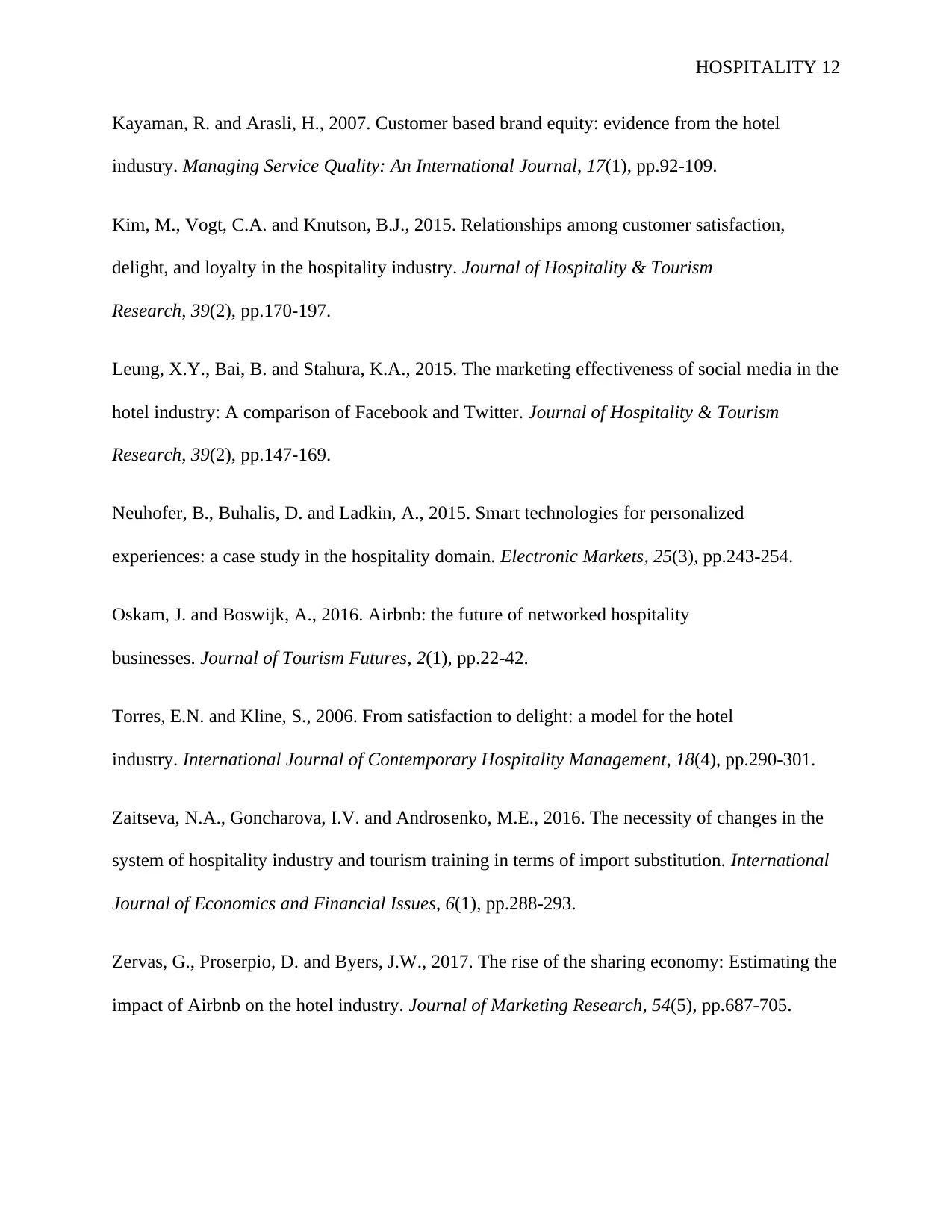
HOSPITALITY 12
Kayaman, R. and Arasli, H., 2007. Customer based brand equity: evidence from the hotel
industry. Managing Service Quality: An International Journal, 17(1), pp.92-109.
Kim, M., Vogt, C.A. and Knutson, B.J., 2015. Relationships among customer satisfaction,
delight, and loyalty in the hospitality industry. Journal of Hospitality & Tourism
Research, 39(2), pp.170-197.
Leung, X.Y., Bai, B. and Stahura, K.A., 2015. The marketing effectiveness of social media in the
hotel industry: A comparison of Facebook and Twitter. Journal of Hospitality & Tourism
Research, 39(2), pp.147-169.
Neuhofer, B., Buhalis, D. and Ladkin, A., 2015. Smart technologies for personalized
experiences: a case study in the hospitality domain. Electronic Markets, 25(3), pp.243-254.
Oskam, J. and Boswijk, A., 2016. Airbnb: the future of networked hospitality
businesses. Journal of Tourism Futures, 2(1), pp.22-42.
Torres, E.N. and Kline, S., 2006. From satisfaction to delight: a model for the hotel
industry. International Journal of Contemporary Hospitality Management, 18(4), pp.290-301.
Zaitseva, N.A., Goncharova, I.V. and Androsenko, M.E., 2016. The necessity of changes in the
system of hospitality industry and tourism training in terms of import substitution. International
Journal of Economics and Financial Issues, 6(1), pp.288-293.
Zervas, G., Proserpio, D. and Byers, J.W., 2017. The rise of the sharing economy: Estimating the
impact of Airbnb on the hotel industry. Journal of Marketing Research, 54(5), pp.687-705.
Kayaman, R. and Arasli, H., 2007. Customer based brand equity: evidence from the hotel
industry. Managing Service Quality: An International Journal, 17(1), pp.92-109.
Kim, M., Vogt, C.A. and Knutson, B.J., 2015. Relationships among customer satisfaction,
delight, and loyalty in the hospitality industry. Journal of Hospitality & Tourism
Research, 39(2), pp.170-197.
Leung, X.Y., Bai, B. and Stahura, K.A., 2015. The marketing effectiveness of social media in the
hotel industry: A comparison of Facebook and Twitter. Journal of Hospitality & Tourism
Research, 39(2), pp.147-169.
Neuhofer, B., Buhalis, D. and Ladkin, A., 2015. Smart technologies for personalized
experiences: a case study in the hospitality domain. Electronic Markets, 25(3), pp.243-254.
Oskam, J. and Boswijk, A., 2016. Airbnb: the future of networked hospitality
businesses. Journal of Tourism Futures, 2(1), pp.22-42.
Torres, E.N. and Kline, S., 2006. From satisfaction to delight: a model for the hotel
industry. International Journal of Contemporary Hospitality Management, 18(4), pp.290-301.
Zaitseva, N.A., Goncharova, I.V. and Androsenko, M.E., 2016. The necessity of changes in the
system of hospitality industry and tourism training in terms of import substitution. International
Journal of Economics and Financial Issues, 6(1), pp.288-293.
Zervas, G., Proserpio, D. and Byers, J.W., 2017. The rise of the sharing economy: Estimating the
impact of Airbnb on the hotel industry. Journal of Marketing Research, 54(5), pp.687-705.
⊘ This is a preview!⊘
Do you want full access?
Subscribe today to unlock all pages.

Trusted by 1+ million students worldwide
1 out of 12
Related Documents
Your All-in-One AI-Powered Toolkit for Academic Success.
+13062052269
info@desklib.com
Available 24*7 on WhatsApp / Email
![[object Object]](/_next/static/media/star-bottom.7253800d.svg)
Unlock your academic potential
Copyright © 2020–2025 A2Z Services. All Rights Reserved. Developed and managed by ZUCOL.





